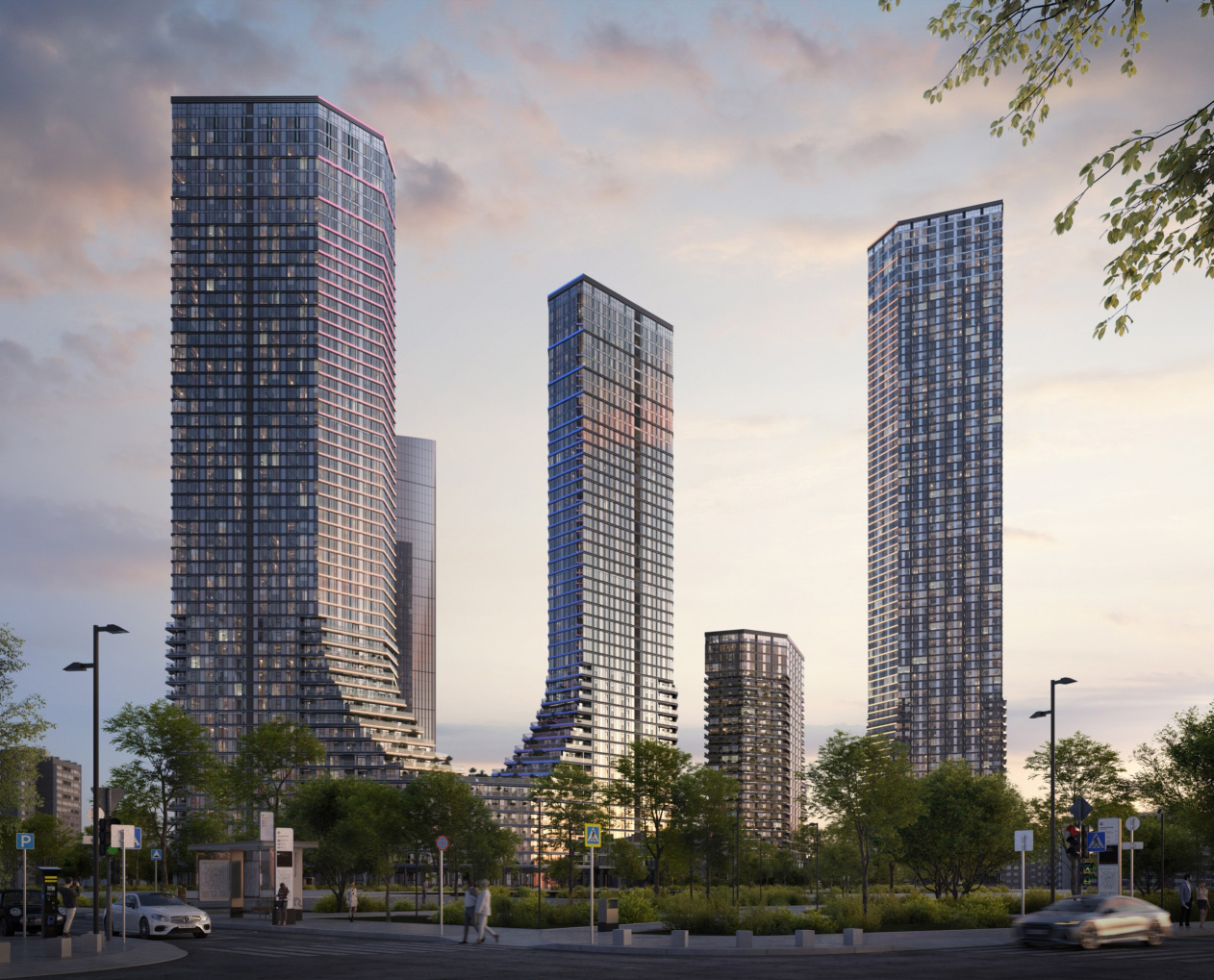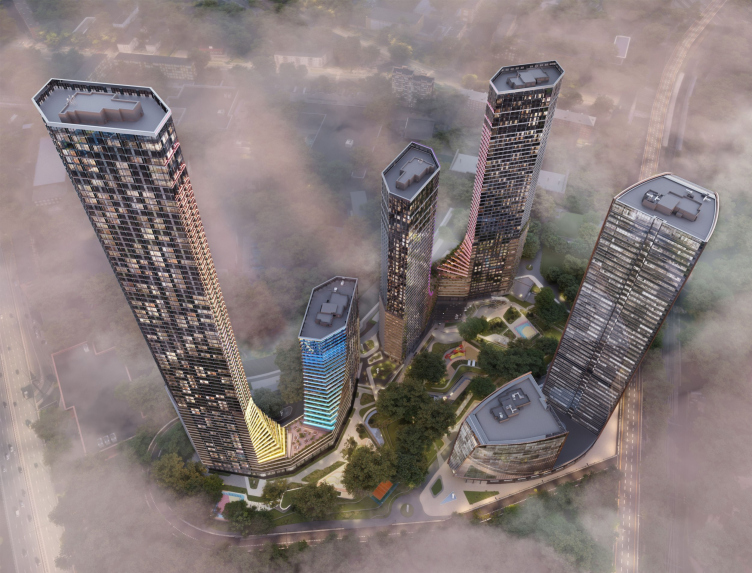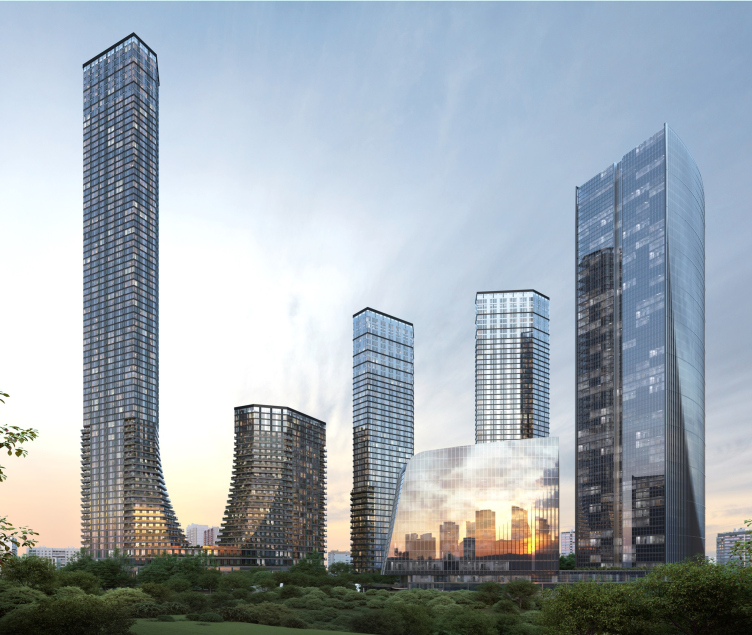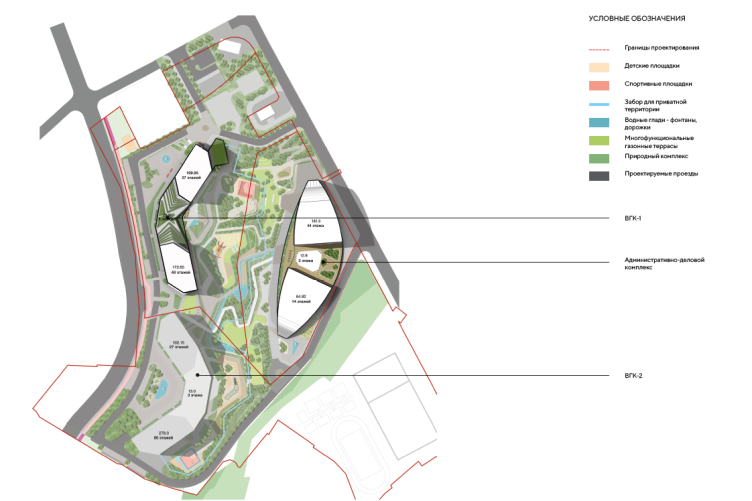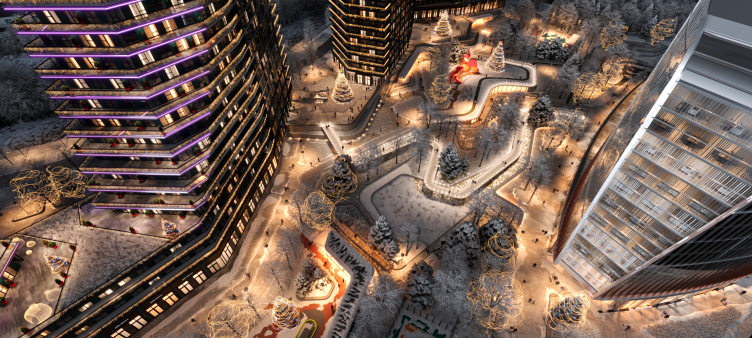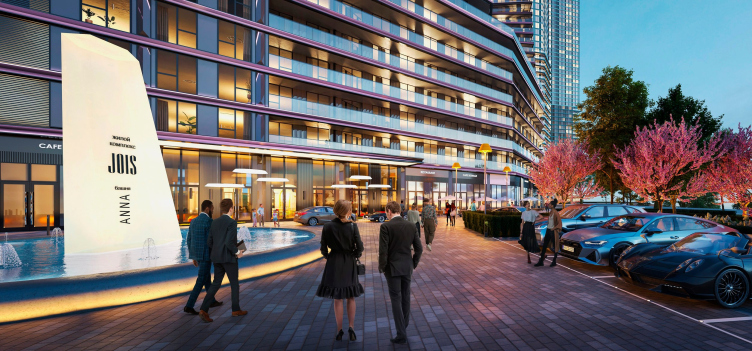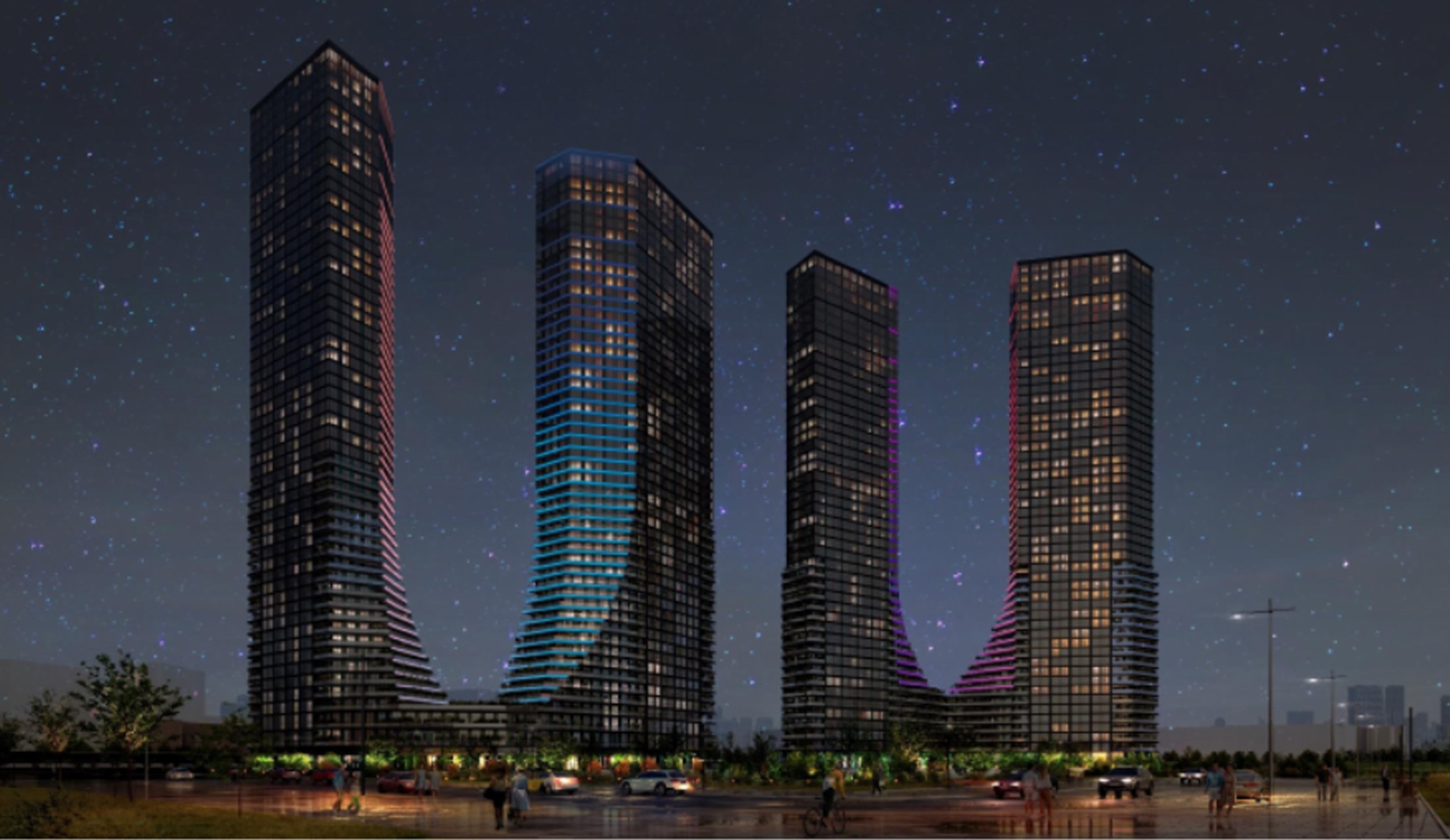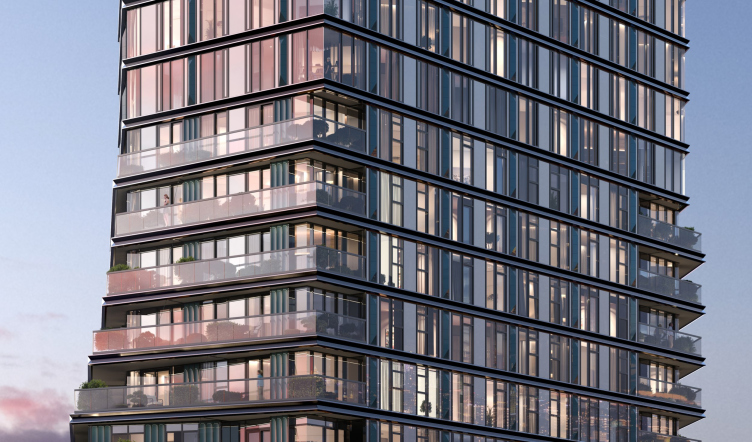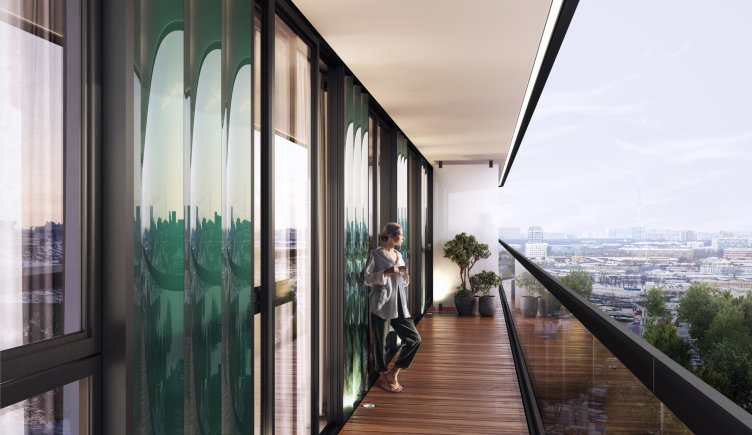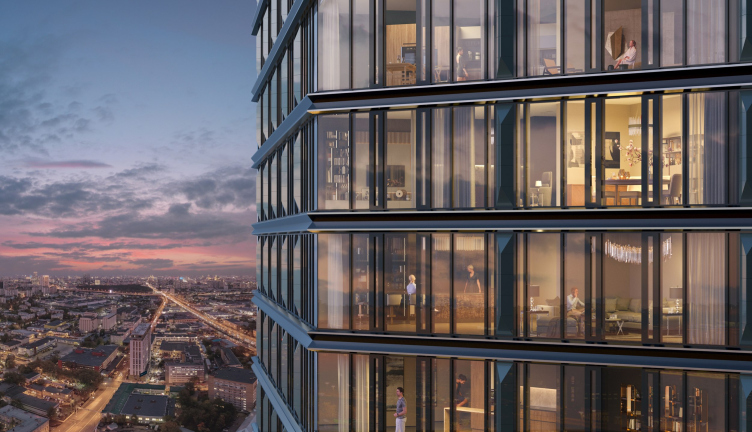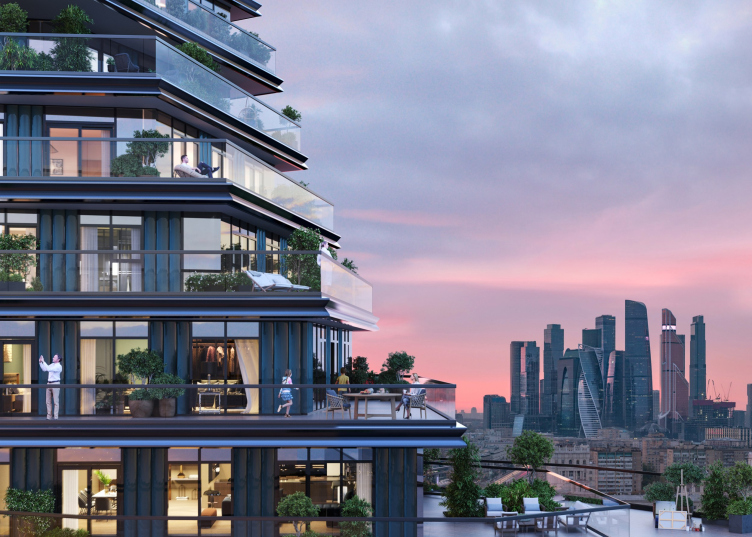In short, the process is ongoing, and against the backdrop of the nation’s capital’s high-rise boom, the goal of such exploration is not just coming up with some non-trivial forms but also testing some prejudices for strength.
Jois multifunctional complex
Copyright: © Genpro
Andy Snow, a British-born architect and creative director of Genpro, positions his project – as he said in an interview with Tatlin magazine, for example – precisely as a myth-buster.
We are really proud of this project. While conceptualizing Jois, we aimed to challenge prevailing myths surrounding skyscrapers, incorporating unique solutions that set a premium standard in Moscow. For instance, we debunked the belief in insufficient fresh air in tall buildings and the absence of small windows – our design features small windows above 75 meters, equipped with protective valves. We also addressed the misconception that skyscrapers lack social spaces and countered the idea that the best apartments with terraces should be reserved for the upper floors.
In our approach, premium apartments are situated in the lower tier, featuring expansive “balcony” terraces that extend across multiple facades and visually engage with the “park” courtyard, generously adorned with greenery. These apartments define the distinctive shape of the buildings, seamlessly emerging from the ground and connecting the tower bases. This form not only presents a recognizable silhouette from a distance but also offers breathtaking views. The process required meticulous effort; for the lower floors, standard layouts were impractical, prompting us to essentially start from scratch. Jois stands out as one of the most extensive and challenging projects in my career.
I express gratitude to the developer, MR-Group, for their understanding and cooperation. We successfully navigated the idea through various iterations of project development, maintaining its original design integrity. The role of Genpro as the general designer has been instrumental in ensuring the complex’s successful execution. In my view, Genpro stands as one of the most robust general design companies in the Russian market.
In our approach, premium apartments are situated in the lower tier, featuring expansive “balcony” terraces that extend across multiple facades and visually engage with the “park” courtyard, generously adorned with greenery. These apartments define the distinctive shape of the buildings, seamlessly emerging from the ground and connecting the tower bases. This form not only presents a recognizable silhouette from a distance but also offers breathtaking views. The process required meticulous effort; for the lower floors, standard layouts were impractical, prompting us to essentially start from scratch. Jois stands out as one of the most extensive and challenging projects in my career.
I express gratitude to the developer, MR-Group, for their understanding and cooperation. We successfully navigated the idea through various iterations of project development, maintaining its original design integrity. The role of Genpro as the general designer has been instrumental in ensuring the complex’s successful execution. In my view, Genpro stands as one of the most robust general design companies in the Russian market.
Jois multifunctional complex
Copyright: © Genpro
Jois is one of the new iconic projects of Moscow’s “skyscraper trend”; its construction began in August 2023. It continues the so-called “Big City” beyond the Zvenigorodskoe Highway, stretching towards Zorge Street, that is, it is part of the “protuberance”, a huge spot of urban territory that was previously almost entirely filled with industrial parks, and is now being intensively cleared and built upon. Nearby is the Moscow Central Ring line, with its “Khoroshevo” station just 300 meters away, making the transportation accessibility of this location excellent. Additionally, nearby is the business center “1Zhukov”, and there are ambitious plans for construction in the adjacent areas. The Jois complex itself will appear on the territory of the former concrete products plant No. 17.
In fact, Jois consists of two high-rise residential complexes – from 48 to 57 floors, with the highest point at 338.5 meters – and an administrative/business center. The plan shape of each of the three objects resembles a boomerang: two two-section residential buildings are opened in different directions, one to the east, the other to the west, and the third one, the office building, being slightly wider, is located closer to the Moscow Central Ring, completing the composition.
Jois multifunctional residential complex, the master plan
Copyright: image provided by Genpro
The two pairs of volumes are arranged on either side of the subway line passing beneath the site, over which a courtyard/park/boulevard is designed, with a tiered contour merging into the surrounding stylobates.
Jois multifunctional residential complex
Copyright: image provided by Genpro
The courtyard/park is meant to compensate for the lack of greenery in the city for the residents and office workers while simultaneously creating a vibrant public space filled with cafes and shops, which is absolutely essential for a complex of this scale.
Jois multifunctional residential complex
Copyright: image provided by Genpro
Jois multifunctional residential complex
Copyright: image provided by Genpro
While the business center consists of two towers with a parabolic plan contour, placed on the “boomerang” stylobate with “bases of parabolas” slices facing each other, the pairs of residential buildings merge on their stylobates with terraces of the lower (premium) apartments to form two giant U-letters – a visually powerful and instantly recognizable form, which has all the grounds to claim an iconic status – a crucial quality for large modern buildings. They resemble horseshoes or magnets, with upward-pointing ends, different in height in one complex, and of an equal height in the other.
Jois multifunctional complex
Copyright: © Genpro
Jois multifunctional complex
Copyright: © Genpro
Terracing the lower floors becomes a successful way to give extra strength to the U-silhouette towers. Their form is not merely “put together”; it is composed of terraces, which, in turn, provide spacious apartments equipped with outdoor leisure space. The terraces are planned to be greened, as seen in the project visualizations, featuring numerous trees in containers, their steps rising from the courtyard and the roof of the stylobate like a kind of green mountain. Above, the live greenery finds its reflection in the form of “diamond rust” metal elements on the glass facades.
The decorative elements on the facades include fiber-concrete and concave terracotta displays of semi-circular shape in section. The terrace railings are made of tempered glass. Between the floors, projecting decorative elements made of “M”-shaped aluminum sheets are used.
Jois multifunctional complex
Copyright: © Genpro
Each lower balcony protrudes further than the upper one, but the upper one also protrudes relative to the wall, creating a canopy over the open balcony-terrace space, providing protection from the sun and rain.
Jois multifunctional complex
Copyright: © Genpro
Jois multifunctional complex
Copyright: © Genpro
This approach simultaneously enriches the form, deconstructing the shape of the towers’ bases, and enhancing the resemblance of those bases to a layered mountain, which is then sculpted into smooth, almost entirely glass, surfaces at the top.
Jois multifunctional complex
Copyright: © Genpro
The volumes of the towers themselves are not rectangular in plan; their corners are cut in the search for optimal views, insolation, and, at the same time, they feature a streamlined, asymmetrically faceted shape. Meanwhile, on the pedestal, as we remember, they are also turned towards each other at an angle – as a result, the contours of the terraces also consistently rotate, forming, when viewed from above, a shape reminiscent of a fractal. It all looks as if the houses had a half-sun skirt and were gently dancing, with their folds moving.
The lower part of the towers seems to be wrapped in additional skin. Or, simply put, the building unfolds before our eyes “putting itself together” from horizontal plates.
It is worth noting that terraces in modern Moscow construction have proven themselves quite effective in recent years – it has become evident that they go a long way to solve the problem of snow removal, and the issue of bad weather is effectively addressed by awnings and, for example, gas lanterns. What is also important, apartments with terraces sell first and at higher prices in residential complexes. Plus, terraces and balconies, all these “inhabited projections”, make the building look more “inhabited” – it interacts better with the city space.
Andy Snow joins those buildings that have already contributed to debunking the myth of the inconvenience of terraces in Moscow's climate and proposes a new step – combining terraces with a skyscraper, merging them into a cohesive “city” where different characteristics of individual parts are fused within an integral volumetric composition.
Jois multifunctional complex
Copyright: © Genpro
And, of course, this opens up beautiful views of the city, from a level comfortable for humans.
Regarding the windows, according to construction regulations, at a significant height, they do not open for ventilation. In Jois, ventilation flaps are applied above 75 meters, with inward-opening and protective screens made of perforated metal placed in front of them. Below 75 meters, apartment windows are made of aluminum profiles with double-glazed windows and noise-proof ventilation valves. Additionally, French balconies with glass panel railings are incorporated into the transparent structures on the residential floors.
In addition to apartments, the project includes children’s clubs, fitness centers, a health center, a spa, and well-designed open spaces for communal activities. Finally, there is the business center. Its task is to enrich the future environment functionally, which is absolutely necessary for 300-meter residential complexes. It is challenging to say how realistic it is to buy an apartment right next to your office or even within the same project, yet Moscow is increasingly recognizing the need for multifunctionality in large new developments.
The sculptural solution of the business center, as noted earlier, somewhat echoes the residential “pairs” while differing from them. Here, there is no U-shaped silhouette or terraces, but the plan contours take on a distinct parabolic outline, and the facades feature a thin, smoothly embedded vertical relief in glass. These details allow the architects to signify the affiliation of office buildings to the entire complex and at the same time indicate their functional distinction: if the residential buildings expand at the bottom, the offices efficiently “pull” their volumes “together”.
In summary, a new tall structure, over 300 meters high, has emerged among Moscow’s new developments with a recognizable form determined by its content.
It wouldn’t be accurate to say that the stepped or gradual growth of a skyscraper from its stylobate, as well as the connection of towers with such bases, is an entirely groundbreaking solution; there are plenty of examples, such as here, here, here, here, and here. Or even here. For buildings of this scale, a transition from a wide bottom to a slender tower at the top – resembling the growth of a tree – is a technique that sort of suggests itself. There are U-shaped solutions, looking like a half-house with a “tail”, and structures more reminiscent of aquatic plants sprouting from calyxes. However, each such solution is usually associated with a large scale and an inclination towards a symbolic expression, easily recognizable from a distance. These U-shaped structures will be quite visible from the windows of the Moscow Central Diameter train. The chances of this project being executed are quite significant.
It is planned that this complex will be built in three phases, starting with the northern pair of residential buildings.

